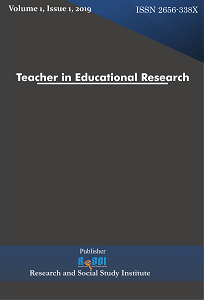YouTube as a source of language input: Early findings on children’s L2 acquisition
DOI:
https://doi.org/10.33292/ter.v6i1.274Keywords:
Second Language Acquisition, YouTube, Early Childhood, Media Exposure, Learning Motivation, L1 influenceAbstract
Evidence on how YouTube contributes to children’s second language (L2) acquisition remains limited, particularly in early childhood settings. This study examines the impact of YouTube and the factors shaping L2 learning among children. Using an exploratory descriptive approach with two participants aged 3 and 5, the study indicates that guided exposure to target-language YouTube content may support incidental gains in vocabulary, common expressions, and context-appropriate language use. Several factors appear to be associated with outcomes: (1) age, with preschoolers showing readiness to uptake novel forms; (2) presentation and input quality, including curated resources and caregiver support; (3) children’s intrinsic motivation to view and imitate; and (4) first-language (L1) influence, which can both facilitate and constrain transfer to L2. The findings suggest that parents and educators should provide active mediation, select developmentally appropriate content, and pair media exposure with offline interaction to enhance the meaningfulness of input. Given the small scale of this study, conclusions should be interpreted cautiously; future research with larger samples and stronger designs is recommended to validate and extend these preliminary insights.
References
Abdullah, M. C. (2020). Pengaruh lingkungan terhadap pemerolehan bahasa pertama anak usia 2 tahun 8 bulan dalam tataran sintaksis. Pena Literasi, 3(1), 42. https://doi.org/10.24853/pl.3.1.329-336
Aitchison, J. (2011). The Articulate Mammal. Routledge. https://doi.org/10.4324/9780203828243
Anggraini, N. (2021). Peranan orang tua dalam perkembangan bahasa anak usia dini. Metafora: Jurnal Pembelajaran Bahasa Dan Sastra, 7(1), 43. https://doi.org/10.30595/mtf.v7i1.9741
Annisa, S. R. (2022). Pengaruh media sosial Youtube pada pemerolehan bahasa kedua anak usia 5 tahun kajian psikolinguistik. Journal Educational of Indonesia Language, 3(2), 10–17. https://doi.org/10.36269/jeil.v3i2.1038
Baradja, M. . (1986). Pemerolehan bahasa pertama. Buku Pegangan Pengajaran Bahasa. Fakultas Pasca Sarjana IKIP Malang.
Burke, S. J. (1974). Language acquisition, language learning, and language teaching. IRAL: International Review of Applied Linguistics in Language Teaching, 12(1), 53.
Campbell, R., & Wales, R. (1970). The study of language acquisition. New Horizons in Linguistics, 1, 242–260.
Carpenter, H. (2012). Secret gardens: a study of the golden age of children’s literature. Faber & Faber.
Choirunnisa, B. C. (2020). Peranan ibu dalam pemerolehan bahasa anak usia 4-5 tahun. Jubindo: Jurnal Ilmu Pendidikan Bahasa Dan Sastra Indonesia, 5(1), 30–37. https://doi.org/10.32938/jbi.v5i1.433
Chomsky, N., & Halle, M. (1965). Some controversial questions in phonological theory. Journal of Linguistics, 1(2), 97–138. https://doi.org/10.1017/S0022226700001134
Fitri, W. E. (2023). Pengaruh tontonan platform youtube dalam pemerolehan bahasa anak. 2(2).
Geers, A. E., Nicholas, J., Tobey, E., & Davidson, L. (2016). Persistent language delay versus late language emergence in children with early cochlear implantation. Journal of Speech, Language, and Hearing Research, 59(1), 155–170. https://doi.org/10.1044/2015_JSLHR-H-14-0173
Ide, N., & Romary, L. (2004). International standard for a linguistic annotation framework. Natural Language Engineering, 10(3–4), 211–225. https://doi.org/10.1017/S135132490400350X
Irwansyah, A., & Shabiburrahman, S. (2022). Pengaruh media Youtube pada pemerolehan bahasa B2 anak usia 3 tahun. NEOLOGIA: Jurnal Bahasa Dan Sastra Indonesia, 3(1), 21–28.
Khairi, H. (2018). Pemerolehan bahasa. Jurnal Warna, 2(2 Desember), 15–28.
Khoiriyati Salis, F. N. (2013). Peran Lingkungan Terhadap Perkembangan Bahasa Anak. Journal of the American Chemical Society, 123(10), 2176–2181.
Krashen, S. D. (1972). Language and the left hemisphere. University of California, Los Angeles.
Kurnia, N., Rahayu, Wendratama, E., Monggilo, Z. M. Z., Damayanti, A., Angendari, D. A. D., Abisono, F. Q., Shafira, I., & Desmalinda. (2022). Penipuan digital di Indonesia.
Levelt, W. J. M. (2013). A history of psycholinguistics: The pre-Chomskyan era. Oxford University Press.
Lust, B. C. (2006). Child language: Acquisition and growth. Cambridge University Press.
Macwhinney, B. (2010). Computational models of child language learning: an introduction. Journal of Child Language, 37(3), 477–485. https://doi.org/10.1017/S0305000910000139
Munger, K., & Phillips, J. (2022). Right-wing YouTube: A supply and demand perspective. The International Journal of Press/Politics, 27(1), 186–219. https://doi.org/10.1177/1940161220964767
Osman, W., Mohamed, F., Elhassan, M., & Shoufan, A. (2022). Is YouTube a reliable source of health-related information? A systematic review. BMC Medical Education, 22(1), 382. https://doi.org/10.1186/s12909-022-03446-z
Puspita, Y., Hanum, F., Rohman, A., Fitriana, F., & Akhyar, Y. (2022). Pengaruh faktor lingkungan keluarga untuk perkembangan pemerolehan bahasa pertama anak usia 2 tahun 5 bulan. Jurnal Obsesi : Jurnal Pendidikan Anak Usia Dini, 6(5), 4888–4900. https://doi.org/10.31004/obsesi.v6i5.2500
Putri, N., Susanto, A., & Nur, T. (2018). Pengaruh konten Youtube Gaming terhadap pemerolehan bahasa anak usia tiga sampai enam tahun. Jurnal Prespektif, 460–470.
Rauschecker, J. P., & Scott, S. K. (2009). Maps and streams in the auditory cortex: nonhuman primates illuminate human speech processing. Nature Neuroscience, 12(6), 718–724. https://doi.org/10.1038/nn.2331
Sakdiyah, R., & Perangin-angin, A. B. (2023). The influence of Youtube on second language acquisition for children 5th years. Innovative: Journal Of Social Science Research, 3(5), 10194–10201. https://doi.org/https://doi.org/10.31004/innovative.v3i5.5409
Schwemmer, C., & Ziewiecki, S. (2018). Social media sellout: The increasing role of product promotion on YouTube. Social Media + Society, 4(3), 205630511878672. https://doi.org/10.1177/2056305118786720
Zikri, R. (2016). Peran orang tua dalam mengoptimalkan perkembangan bahasa anak fase golden age. Universitas Negeri Yogyakarta, 15(1), 165–175.
Downloads
Published
How to Cite
Issue
Section
Citation Check
License
Copyright (c) 2024 Teacher in Educational Research

This work is licensed under a Creative Commons Attribution-ShareAlike 4.0 International License.

Teacher in Educational Research is licensed under a Creative Commons Attribution-ShareAlike 4.0 International License.
Based on a work at http://ejournal.ressi.id/index.php/TER.







